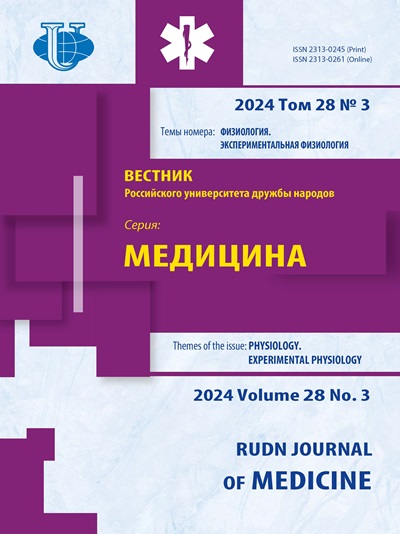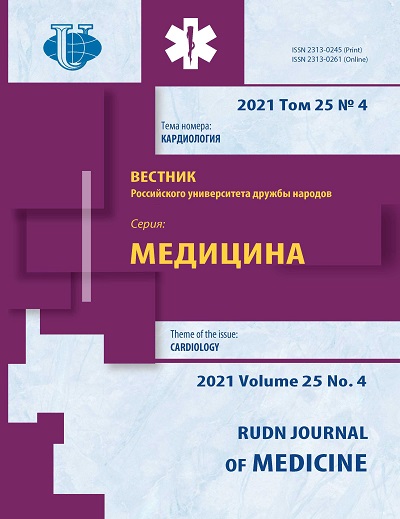Развитие и функциональное значение системы лёгочного сурфактанта
- Авторы: Шахбанов Р.К.1, Асадулаева М.Н.1, Алиева С.Н.1, Алимханова А.А.1
-
Учреждения:
- Дагестанский государственный медицинский университет
- Выпуск: Том 25, № 4 (2021): КАРДИОЛОГИЯ
- Страницы: 321-331
- Раздел: ПУЛЬМОНОЛОГИЯ
- URL: https://journals.rudn.ru/medicine/article/view/29718
- DOI: https://doi.org/10.22363/2313-0245-2021-25-4-321-331
Цитировать
Полный текст
Аннотация
Актуальность . Предотвращение развития послеоперационного острого респираторного дистресс-синдрома при операциях на нисходящем отделе грудной аорты повышает эффективность терапии. Исследование повреждения комплекса сурфактанта при ишемии и реперфузии легких является актуальными, так как предполагает профилактическое применение препарата сурфактанта при операциях на нисходящем отделе грудной аорты, для которых характерен высокий риск развития послеоперационного острого респираторного дистресс-синдрома. Цель исследования: повысить эффективность фармакологической и респираторной терапии острого респираторного дистресс-синдрома, а также выявить роль сурфактантной системы легких в возникновении воспаления на фоне туберкулеза и развитии механизмов регенерации, которые влияют на течение и исход заболевания. Материалы и методы. В исследовании приняли участие 24 человека, из них пациенты-добровольцы в количестве 14 человек, имеющих диагностированное заболевание респираторного характера, в остром течении. Выборка в 14 человек сформировалась исключительно из-за соответствия данных пациентов критериям включения: наличие острого респираторного дистресс-синдрома различного генеза. Результаты и обсуждение. Для комплексного лабораторного определения применялся алгоритм, который соответствовал государственному стандарту, для идентификации острого респираторного дистресс-синдрома. Для каждого участника экспериментов предполагалась разработка плана лечебных процедур с учетом индивидуализации и стандартизации. Выводы. Отдельные результирующие данные собраны относительно легочной системы сурфактантного типа, что представлено в формате компакторной модели. Здесь отражены ряд базисных компонентов, которые классифицируются по клеточному и неклеточному фактору. При этом субстанция-сурфактант способствует уменьшению выраженной отечности, что позволяет существенно снизить процесс «склеивания» альвеолярных структур при вдохе. Все это складывалось в нормальную систему газового обмена в легочных структурах, включая контроллинг мукоцилитарной системы, выступающей в качестве натурального стимулятора функции альвеолярных макрофагов.
Ключевые слова
Об авторах
Р. К. Шахбанов
Дагестанский государственный медицинский университет
Автор, ответственный за переписку.
Email: djami_ramazanova@mail.ru
ORCID iD: 0000-0002-3573-2434
г. Махачкала, Российская Федерация
М. Н. Асадулаева
Дагестанский государственный медицинский университет
Email: djami_ramazanova@mail.ru
ORCID iD: 0000-0002-9006-0992
г. Махачкала, Российская Федерация
С. Н. Алиева
Дагестанский государственный медицинский университет
Email: djami_ramazanova@mail.ru
ORCID iD: 0000-0001-6824-2274
г. Махачкала, Российская Федерация
А. А. Алимханова
Дагестанский государственный медицинский университет
Email: djami_ramazanova@mail.ru
ORCID iD: 0000-0002-1651-0369
г. Махачкала, Российская Федерация
Список литературы
- Кассиль В.Л., Сапичева Ю.Ю. Острый респираторный дистресссиндром и гипоксемия // М.: МЕДпресс-информ. 2016. 150 с.
- Геккиева О.В., Баутин А.Е., Осовских В.В., Трегубова И.В., Козетинский Р.А., Сейлиев А.А. и др. Профилактическое применение препарата сурфактанта при операциях на органах грудной полости с высоким риском развития дыхательной недостаточности // Доктор.Ру. 2016. N12. С. 38-43.
- Филоненко Т.Г. Роль сурфактант-ассоциированного белка SP-A в системе местной защиты легких // Патология. 2012. N3. С. 117.
- Ступак В.С., Левкова Е.А. Теоретические и практические аспекты лечения больных групп риска в эпидемию высокопатогенного гриппа A/H1N1 // Дальневосточный журнал инфекционной патологии. 2010. Т. 17. N17. С. 25-27.
- Романенко Н.А., Бессмельцев С.С., Чечёткин А.В. Коррекция иммунного статуса пациентов иммуноглобулином человека для внутривенного введения // Казанский мед. журнал. 2017. N5. С. 775-783.
- Володин Н.Н., Дегтярев Д.Н., Бабак О.А., Левадная А.В. Использование экзогенного сурфактанта у недоношенных детей при бронхолегочной дисплазии // Вестн. Рос. Гос. мед. университета. 2010. N2. С. 41-46.
- Васильева И.А., Белиловский Е.М., Борисов С.Е., Стерликов С.А. Глобальные отчеты Всемирной организации здравоохранения по туберкулезу: формирование и интерпретация // Туберкулез и болезни легких. 2017. № 5(95). С. 7-16.
- Яблонский П.К., Вишневский Б.И., Соловьева Н.С., Маничева О.А., Догонадзе М.З., Мельникова Н.Н., Журавлев В.Ю. Лекарственная устойчивость Mycobacterium tuberculosis при различных локализациях заболевания // Инфекция и иммунитет. 2016. Т. 6. N2. С. 133-140.
- Mummadi S.R. Clinically significant variability of serum Ig E concentrations in patients with severe astma // J Astma. 2012. Vol. 4. № 2. P. 42-47.
- Позднякова О.Ю., Батурин В.А. Структура бактериальной инфекции у пациентов с бронхиальной астмой // Кубанский научный медицинский вестник. 2012. Т. 133. № 4. С. 80-82.
- Лямина С.В., Круглов С.В., Веденикин Т.Ю. Новая стратегия управления иммунным ответом при заболеваниях легких - роль сурфактантного белка D как бивалентного фактора репрограммирования макрофагов // Фундаментальные исследования. 2011. N1. С. 90-98.
- Ильин А.В. Современные методы диагностики бронхиальной астмы (обзор литературы) // Бюллетень физиологии и патологии дыхания. 2012. № 43. С. 116-123.
- Розенберг О.А. Препараты легочного сурфактанта при острых и хронических заболеваниях легких (Часть II) // Общая реаниматология. 2014. Т. 5. № 10. С. 69-86. doi: 10.15360/18139779-2014-5-69-86
- Баутин А.Е., Розенберг О.А., Сумин С.А. Острый респираторный дистресс-синдром. В кн.: Сумин С.А., Шаповалов К.Г. (ред.). Анестезиология и реаниматология // М.: МИА. 2018. С. 103-19.
- Eungdamrong J., Fischer M., Patel R., Meehan S., Sanchez M. Anetoderma secondary to antiphospholipid antibodies // Dermatol Online J. 2012. Vol. 18. No 12. P. 26.
- Баутин А.Е., Авдеев С.Н., Сейлиев А.А., Швечкова М.В., Мержоева З.М., Трушенко Н.В. и др. Ингаляционная терапия сурфактантом в комплексном лечении тяжелой формы COVID19-пневмонии // Туберкулез и болезни легких. 2020. N98(9). С. 6-12. doi: 10.21292/2075-1230-2020-98-9-6-12.
- Ackerman S., Kwatia M., Doyle C. Hydrolysis of Surfactant Phospholipids Catalyzed by Phospholipase A2 and Eosinophil Lysophospholipases Causes Surfactant Dysfunction // Chest. 2003. № 123. P. 355-361. doi: https://doi.org/10.1378/chest.123.3_ suppl.355S
- Лямина, С.В. Новая стратегия управления иммунным ответом при заболеваниях легких // Терапевт. 2011. № 2. С. 47-48.
- Малышев И.Ю., Лямина С.В., Шимшелашвили Ш.Л. Функциональные ответа альвеолярных макрофагов, сурфактантный белок D и заболевания легких // Пульмонология. 2011. № 3. С. 101-107.
- Wang J., Shieh C., Yu C. Allergen-induced bronchial inflammation is associated with decreased levels of surfactant proteins A and D in a murine model of asthma. Clin. Exp // Allergy. 2001. N31. P. 652-662.
















